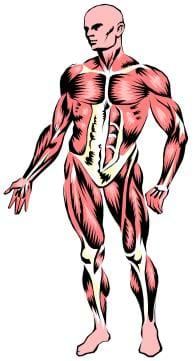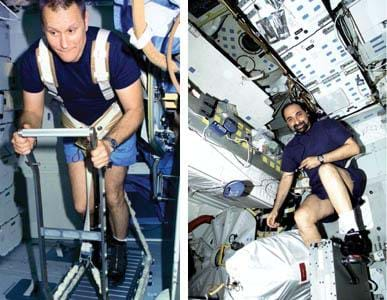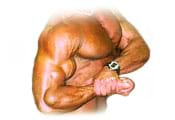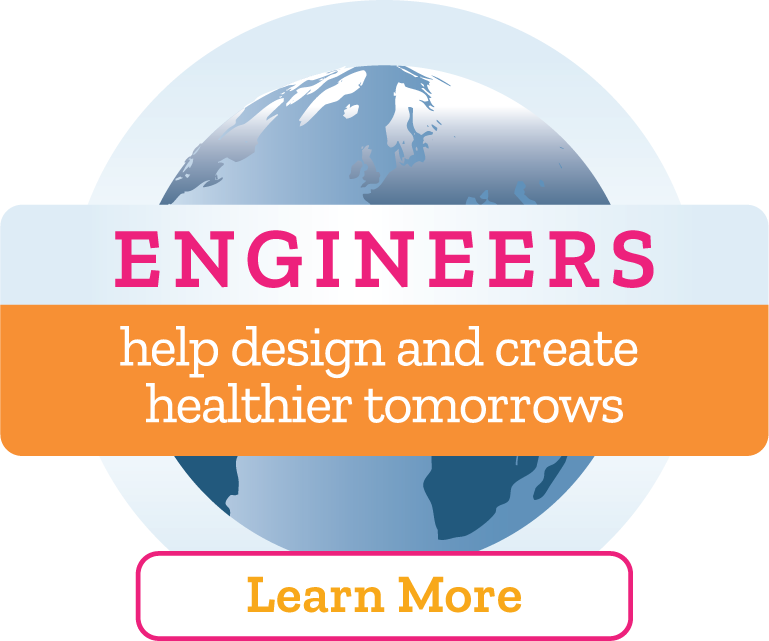Quick Look
Grade Level: 5 (3-5)
Time Required: 15 minutes
Lesson Dependency: None
Subject Areas: Biology
Summary
Students learn all about muscles, including the three different types of muscles in the human body and the effects of microgravity on muscles. They also learn how astronauts must exercise in order to lessen muscle atrophy in space. Students discover what types of equipment engineers design to help the astronauts exercise while in space.
Engineering Connection
Engineers need to understand how the human body works in order to help astronauts stay healthy in outer space. The microgravity of outer space leads to muscle atrophy, and so scientists and engineers at NASA work to design special exercise machines to help the astronauts maintain muscle strength during space flight.
Learning Objectives
After this lesson, students should be able to:
- List the three different kinds of muscles.
- Describe the difference between voluntary and involuntary muscle control.
- Explain what happens to muscles in outer space.
- Describe the importance of exercising both on Earth and in outer space.
Educational Standards
Each TeachEngineering lesson or activity is correlated to one or more K-12 science,
technology, engineering or math (STEM) educational standards.
All 100,000+ K-12 STEM standards covered in TeachEngineering are collected, maintained and packaged by the Achievement Standards Network (ASN),
a project of D2L (www.achievementstandards.org).
In the ASN, standards are hierarchically structured: first by source; e.g., by state; within source by type; e.g., science or mathematics;
within type by subtype, then by grade, etc.
Each TeachEngineering lesson or activity is correlated to one or more K-12 science, technology, engineering or math (STEM) educational standards.
All 100,000+ K-12 STEM standards covered in TeachEngineering are collected, maintained and packaged by the Achievement Standards Network (ASN), a project of D2L (www.achievementstandards.org).
In the ASN, standards are hierarchically structured: first by source; e.g., by state; within source by type; e.g., science or mathematics; within type by subtype, then by grade, etc.
NGSS: Next Generation Science Standards - Science
-
A system can be described in terms of its components and their interactions.
(Grades 3 - 5)
More Details
Do you agree with this alignment?
International Technology and Engineering Educators Association - Technology
-
Technological advances have made it possible to create new devices, to repair or replace certain parts of the body, and to provide a means for mobility.
(Grades
3 -
5)
More Details
Do you agree with this alignment?
-
Demonstrate how tools and machines extend human capabilities, such as holding, lifting, carrying, fastening, separating, and computing.
(Grades
3 -
5)
More Details
Do you agree with this alignment?
State Standards
Colorado - Science
-
Develop and communicate an evidence-based scientific explanation regarding how humans address basic survival needs
(Grade
5)
More Details
Do you agree with this alignment?
-
Assess further scientific explanations regarding basic human body system functions
(Grade
5)
More Details
Do you agree with this alignment?
Introduction/Motivation
Astronauts get to do all sorts of amazing things! How would you like to visit the International Space Station, go on a space walk, or look down on planet Earth from outer space? That would be pretty cool!
Yes, astronauts have an incredible job, but it is also a tough one. One of the numerous challenges that astronauts face is to identify and accommodate for the many affects that outer space has on their health. One effect is muscle atrophy ─ which means that when astronauts are away from Earth in a microgravity environment for a long time, their muscles become smaller and much weaker. Essentially, this means that muscles shrink! This is because in outer space, there is very little gravity (microgravity), so hardly any force or "load" pulls down on the astronauts' muscles. On Earth, we have constantly resist the force of gravity every day ─ which helps to keep our muscles working and strong. But in outer space, the astronauts need not resist gravity, so their muscles get weaker and eventually atrophy. According to researchers, after just 5 to 11 days in space, astronauts can lose up to 20% of muscle fibers – that is a lot of loss!
What do you know about muscles? Do you know that every person has three different types of muscle in their body? The first type of muscle is called cardiac muscle. These are the muscles in your heart. The second type of muscle is called smooth muscle. These muscles line your stomach and other internal organs. The third type of muscle is skeletal muscle. The muscles are attached to your bones and help you move around. Skeletal muscles are the ones you can see when you flex your arm or leg. Skeletal muscles are also the only muscles that you can move by thinking about them. We call skeletal muscles voluntary muscles because you can volunteer to move them whenever you want to engage (activate) them. Cardiac and smooth muscles are involuntary because they move without you thinking about them. (Write the three muscle types on the board.)

We know that if you reduce the loads, or weight, on your muscles, they will atrophy and get weaker. But, the great thing about muscles is that once you put weight on them again, they will begin to grow stronger. That is what happens when a person lifts heavy weights (e.g., weight lifters). Their skeletal muscles react to the repetitive lifting and eventually get stronger. So, the very best thing that astronauts can do to keep their muscles strong is to exercise. The type of exercise the astronauts do is very important – it has to be resistance exercise, which means it has to create a load on their muscles. But, exercising is tricky in outer space! Remember, there is very little gravity, so if an astronaut tried lifting heavy weights, they would feel incredibly light and take little effort to lift. Therefore, how do astronauts get the exercise they need? Engineers at NASA have developed special machines to help astronauts create a load on their muscles, even in microgravity.
Even though you may not be an astronaut, you can learn from their example. When people on Earth get older, their physical activity often slows down and their muscles begin to atrophy also, just like in outer space. So, if you want to have strong, healthy muscles when you get old, you need to put loads on your muscles and exercise – just like the astronauts. Today we are going to learn more about muscles and how engineers help keep astronaut's muscles healthy and strong in space. Following the lesson, conduct the associated activities Walk, Run, Jump! and Muscles, Muscles Everywhere to expand students' knowledge of muscles and special considerations for those of astronauts!
Lesson Background and Concepts for Teachers
How would you dance, write or smile without your muscles? You couldn't; it would be impossible! Muscles are in charge of all the body's movements.
About 40% of the weight of the body is muscle. Some muscles get their instructions from the nervous system, which sends electrical impulses to the muscles telling them to move. However, your heart, which is made up of cardiac muscle, can contract all by itself, without directions from the brain.
Muscles get their energy from glucose that is carried in blood cells through the body. The body also stores glucose in the muscles as glycogen. Then, when you exercise, the glycogen is broken down to provide energy.
Muscles are made up of fibers. The more a fiber contracts, the shorter the entire muscle becomes. The fibers consist of bundles of myofibril which contains two types of filaments ─ called myofilaments: thin filaments, primarily made of the actin protein, and thick filaments, primarily made of the myosin protein. These myofilaments are bundled together to create myofibrils. These myofibrils are then bundled together to create a skeletal muscle fiber.

When a muscle is stimulated, an action potential travels over the muscle fiber membrane and causes a contraction. In a contracted state, the actin (thin) filaments are pulled inward among the myosin (thick) filaments so that the filaments then overlap each other.
There are three different types of muscle: skeletal muscle, smooth muscle and cardiac muscle. Of these, only the skeletal muscles are controlled by conscious thought.

The muscles visible on the outside of the human body are skeletal muscles. (See Vocabulary for specific types.) Arranged in parallel bundles and attached to bones by tendons, some of the skeletal muscles are the largest and most powerful muscles in the human body. Skeletal muscles include ones located in the arms, legs, neck, tongue and face. Tendons are located wherever there are skeletal muscles, helping to make a powerful movement team by attaching the muscles to bone.
The smooth muscles make up hollow internal organs, which include organs such as blood vessels, the gastrointestinal tract and the bladder. They use much less energy than the skeletal muscles and do not require conscious thought to make them work ─ try telling your stomach to contract! Also, the speed of smooth muscle contraction is much slower than the skeletal muscle.
The cardiac muscle is the muscle that makes up the walls of the heart. Unlike the skeletal muscle, the heart takes a lifetime to tire. It pumps blood through the entire body continuously. Blood carries oxygen, and the cardiac muscle needs continuous unobstructed oxygen to keep it alive, so when a heart attack occurs (and blood stops flowing) the cardiac muscle rapidly dies.
Associated Activities
- Walk, Run, Jump! - Students try different exercises to learn more about the muscles in their bodies.
- Muscles, Muscles Everywhere - Students investigate the different muscles and discuss how they are used. They work in teams to design exercise machines for astronauts to use in outer space.
Lesson Closure
Let's review the different kinds of muscles. Who can remember what a smooth muscle is and give us some examples? (Answer: Smooth muscles make up hollow internal organs, like the bladder or stomach.) What about skeletal muscles? (Answer: Skeletal muscles are muscles attached to bone that you can see when you exercise.) Who can remember the third type of muscle? (Answer: Cardiac muscles; the muscles in the heart.) Which of the three muscle types is voluntary (i.e., you can move by thinking about them)? (Answer: skeletal) Skeletal muscles are the only voluntary type of muscle. Other muscles are involuntary since we can not control the contraction of our stomach and heart, for example. What do astronauts need to do in space to help keep their muscles strong? (Answer: exercise) What do we need to do here on Earth to keep our own muscles strong? (Answer: exercise) Engineers help keep people's muscles healthy and strong in space by designing special exercise equipment that provides muscle load in a microgravity (little gravity) environment.
Vocabulary/Definitions
actin: One of the two types of protein that make up myofilaments.
bicep: Skeletal muscles found in the upper arm.
cardiac muscle: Involuntary muscles located in the heart.
deltoid: Skeletal muscles found in the shoulder area.
gluteus maximus: Skeletal muscles found in your behind (rear end).
microgravity: An environment in which exists very little net gravitational force (free-falling).
myofibril: A bundle of myofilaments.
myology: The study of muscle.
myosin: One of the two types of protein that make up myofilaments.
pectoralis: A skeletal muscle found on each side of the upper chest (pecs).
quadricep: A skeletal muscle found at the front of the thigh (quads).
rectus abdominus: A skeletal muscle found under the rib cage (abs).
skeletal muscle: Voluntary muscles attached to bone.
smooth muscle: Involuntary muscles located in the hollow internal organs.
tendon: Tough tissue that attaches skeletal muscles to bone.
Assessment
Pre-Lesson Assessment
Discussion Question: Solicit, integrate and summarize student responses. Write their ideas on the board. Tell the students these questions will be answered in the lesson.
- What do muscles do? (Answer: Help us move, eat, go to the bathroom, play sports, dance, walk, talk, smile, etc.)
- What do you think happens to our muscles when we travel into outer space? (Answer: They atrophy, or grow weaker/shrink. Note: Write down student ideas on the board.)
- Do you think engineers need to know about muscles? Why? (Answer: Yes, so that they can help astronauts while traveling in space, and help design ways to take care of people's muscles here on Earth, with devices such as prosthetics, wheelchairs, crutches, special exercise equipment for people with disabilities, etc.)
Post-Introduction Assessment
Voting: Ask a true/false question and have students vote by holding thumbs up for true and thumbs down for false. Count the votes and write the totals on the board. Give the right answer.
- True or False: There are four different kinds of muscles. (Answer: False; there are three different kinds of muscle in the human body.)
- True or False: Some engineers need to know how muscles work (Answer: True)
- True or False: Astronauts do not need to exercise in outer space (Answer: False; astronauts need to exercise to keep their muscles from atrophying, or shrinking.)
- True or False: When we get old, our muscles get weaker (Answer: True)
- True or False: Exercising helps our muscles stay strong (Answer: True)
- True or False: Rough muscle is one type of muscle (Answer: False, the three types of muscle are cardiac, smooth and skeletal.)
- True or False: We can control all of our muscles and tell them when to move (Answer: False, we can only control skeletal muscles.)
- True or False: Cardiac muscle is found in the heart (Answer: True)
- True or False: Skeletal muscle is voluntary muscle (Answer: True)
Lesson Summary Assessment
Human Matching: On ten separate pieces of paper, write the terms and the definitions of the five concepts listed below (each on a separate piece of paper). Ask for 10 volunteers from the audience to come up to the front of the room, and give each volunteer one of the pieces of paper. Have all volunteers read what is written on their papers one at a time. Have the audience match term to definition by voting. Have students with "terms" stand by their "definitions." At the end, give a brief explanation of concepts.
- Smooth muscle — Muscles located in the hollow internal organs (like our stomach or bladder); involuntary
- Cardiac muscle —Muscles located in the heart; involuntary
- Skeletal muscle —Muscles attached to bone; voluntary
- Muscle atrophy — Weakening of our muscles (from microgravity and/or aging)
- Exercise — Way to keep our muscles strong
Lesson Extension Activities
Talk about the importance of exercising our muscles here on Earth. Have students create a flyer about exercise and exercise equipment for the next space mission.
Check out this video of the explanation of the process of cardiac muscle contraction: https://www.youtube.com/watch?v=LLNpue1R-xE
Subscribe
Get the inside scoop on all things TeachEngineering such as new site features, curriculum updates, video releases, and more by signing up for our newsletter!More Curriculum Like This

Students learn about the three different types of muscles and how outer space affects astronauts' muscles. Through the design of their own microgravity exercise machine, students learn about the exercise machines that engineers design specifically for astronaut use.

In this activity, students participate in a series of timed relay races using their skeletal muscles. They compare the movement of skeletal muscle and relate how engineers help astronauts exercise skeletal muscles in space.

This lesson describes how the circulatory system works, including the heart, blood vessels and blood. Students learn about the chambers and valves of the heart, the difference between veins and arteries, and the different components of blood.

This lesson covers the topic of human bones and joints. Students learn about the skeleton, the number of and types of bones in the body, and how outer space affects astronauts' bones. Students also learn how to take care of their bones here on Earth to prevent osteoporosis ─ or weakening of the bone...
References
Bedford, Anthony and Fowler, Wallace. Engineering Mechanics: Statics/Dynamics, Second Edition, Addison-Wesley Longman, Inc.: New York, 1999.
Fox, Stuart. Human Physiology, Ninth Edition, McGraw-Hill Science: New York, 2005.
Miller, Karen and Phillips, Tony. National Aeronautics and Space Administration, Systems Mission Directorate at NASA's Marshall Space Flight Center Science@NASA, Patches for a Broken Heart, November 7, 2005.
National Aeronautics and Space Administration (NASA), Space Research, The Office of Biological and Physical Research, Pumping Iron in Microgravity, January 22, 2004, http://spaceresearch.nasa.gov/general_info/pumpingiron.html
National Aeronautics and Space Administration (NASA), Johnson Space Center, Muscle Atrophy, http://www.nasa.gov/pdf/64249main_ffs_factsheets_hbp_atrophy.pdf
National Aeronautics and Space Administration (NASA), Johnson Space Center, Astronaut Fitness/Physical Conditioning, http://www.nasa.gov/pdf/64247main_ffs_factsheets_fitness.pdf
Nemours Foundation, Kids Health For Kids, Seeing Skeletal Muscles, 1995-2003 (available online; search for Nemours Foundation through any Internet search engine).
Nemours Foundation, Kids Health For Kids, Your Multitalented Muscles, 1995-2003 (available online; search for Nemours Foundation through any Internet search engine).
Parker, Steve. How the Body Works, ed. Dorling Kindersley Limited, London. Reader's Digest Books: New York, 1999.
Petty, John Ira. National Aeronautics and Space Administration (NASA), For Media and Press, Press Kits, Fit for Space Multimedia, "Fitness in Space" (video), February 26, 2006, http://www.nasa.gov/audience/formedia/presskits/ffs_interactive.html
U.S. Department of Health and Human Services, The President's Council on Physical Fitness and Sports, Publications, Council Publications, Winning Nutrition for Athletes, October 15, 2004, http://www.fitness.gov/
U.S. National Cancer Institute's Surveillance, Epidemiology and End Results (SEER) Program, Training Website, Anatomy and Physiology, Muscular System, Muscle Types (available online; search for SEER Program through any Internet search engine).
Wikipedia Foundation, Inc. Myofibril, March 21, 2006, http://en.wikipedia.org/wiki/Myofibril
Copyright
© 2006 by Regents of the University of ColoradoContributors
Jessica Todd; Sara Born; Emily Weller; Abigail Watrous; Denali Lander; Malinda Schaefer Zarske; Janet YowellSupporting Program
Integrated Teaching and Learning Program, College of Engineering, University of Colorado BoulderAcknowledgements
The contents of this digital library curriculum were developed under grants from the Fund for the Improvement of Postsecondary Education (FIPSE), U.S. Department of Education and National Science Foundation (GK-12 grant no. 0338326). However, these contents do not necessarily represent the policies of the Department of Education or National Science Foundation, and you should not assume endorsement by the federal government.
Last modified: June 12, 2024









User Comments & Tips